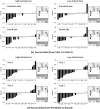Dynamic balance changes within three weeks of fitting a new prosthetic foot component
- PMID: 28704685
- PMCID: PMC5645235
- DOI: 10.1016/j.gaitpost.2017.07.003
Dynamic balance changes within three weeks of fitting a new prosthetic foot component
Abstract
Balance during walking is of high importance to prosthesis users and may affect walking during baseline observation and evaluation. The aim of this study was to determine whether changes in walking balance occurred during an adaptation period following the fitting of a new prosthetic component. Margin of stability in the medial-lateral direction (MOSML) and an anterior instability margin (AIM) were used to quantify the dynamic balance of 21 unilateral transtibial amputees during overground walking. Participants trialled two prosthetic feet presenting contrasting movement/balance constraints; a Higher Activity foot similar to that of their own prosthesis, and a Lower Activity foot. Participants were assessed before (Visit 1) and after (Visit 2) a 3-week adaptation period on each foot. With the Higher Activity component, MOSML decreased on the prosthetic side, and increased on the sound side from Visit 1 to Visit 2, eliminating a significant inter-limb difference apparent at Visit 1 (Visit 1-sound=0.062m, prosthetic=0.075m, p=0.018; Visit 2-sound=0.066m, prosthetic=0.074m, p=0.084). No such change was seen with the Lower Activity foot (Visit 1-sound=0.064m, prosthetic=0.077m, p=0.007; Visit 2-sound=0.063m, prosthetic=0.080m, p<0.001). Significant changes in AIM were observed at Visit 2 (Visit 1: -0.16 (0.08) m, Visit 2: -0.17 (0.08) m; F=23.396, p<0.01). These findings suggest that changes in balance during walking can occur following the initial receipt of a device regardless of whether the component is of the same functional category as the one an individual is accustomed to using.
Keywords: Amputee; Biomechanics; Gait; Rehabilitation; Walking.
Copyright © 2017. Published by Elsevier B.V.
Conflict of interest statement
Conflicts of interest: None.
Figures





Similar articles
-
Lower-limb amputee recovery response to an imposed error in mediolateral foot placement.J Biomech. 2014 Sep 22;47(12):2911-8. doi: 10.1016/j.jbiomech.2014.07.008. Epub 2014 Jul 30. J Biomech. 2014. PMID: 25145315
-
Lower limb amputee gait characteristics on a specifically designed test ramp: Preliminary results of a biomechanical comparison of two prosthetic foot concepts.Gait Posture. 2019 Feb;68:161-167. doi: 10.1016/j.gaitpost.2018.11.017. Epub 2018 Nov 16. Gait Posture. 2019. PMID: 30497035
-
The effects of prosthetic foot stiffness on transtibial amputee walking mechanics and balance control during turning.Clin Biomech (Bristol). 2017 Nov;49:56-63. doi: 10.1016/j.clinbiomech.2017.08.003. Epub 2017 Aug 15. Clin Biomech (Bristol). 2017. PMID: 28869812
-
Foot biomechanics during walking and running.Mayo Clin Proc. 1994 May;69(5):448-61. doi: 10.1016/s0025-6196(12)61642-5. Mayo Clin Proc. 1994. PMID: 8170197 Review.
-
Methodological tools used for tripping gait analysis of elderly and prosthetic limb users: a systematic review.Aging Clin Exp Res. 2020 Jun;32(6):999-1006. doi: 10.1007/s40520-019-01286-4. Epub 2019 Aug 6. Aging Clin Exp Res. 2020. PMID: 31388981
Cited by
-
Biomechanical evaluation over level ground walking of user-specific prosthetic feet designed using the lower leg trajectory error framework.Sci Rep. 2022 Mar 29;12(1):5306. doi: 10.1038/s41598-022-09114-y. Sci Rep. 2022. PMID: 35351910 Free PMC article.
-
Effect of concurrent training in unilateral transtibial amputees using Paralympic athletes as a control group.Clinics (Sao Paulo). 2023 Apr 8;78:100165. doi: 10.1016/j.clinsp.2023.100165. eCollection 2023. Clinics (Sao Paulo). 2023. PMID: 37037074 Free PMC article. Clinical Trial.
-
Dynamic gait stability and stability symmetry for people with transfemoral amputation: A case-series of 19 individuals with bone-anchored limbs.J Biomech. 2024 Jun;171:112208. doi: 10.1016/j.jbiomech.2024.112208. Epub 2024 Jun 25. J Biomech. 2024. PMID: 38941842 Free PMC article.
References
-
- van der Linde H, Hofstad CJ, Geurts ACH, Postema K, Geertzen JHB, van Limbeek J. A systematic literature review of the effect of different prosthetic components on human functioning with a lower-limb prosthesis. J Rehabil Res Dev. 2004;414:555–70. - PubMed
-
- Legro MW, Reiber GE, Czerniecki JM, Sangeorzan BJ. Recreational activities of lower-limb amputees with prostheses. J Rehabil Res Dev. 2001;383:319–25. - PubMed
-
- Miller WC, Deathe AB, Speechley M, Koval J. The influence of falling, fear of falling, and balance confidence on prosthetic mobility and social activity among individuals with a lower extremity amputation. Arch Phys Med Rehabil. 2001;829:1238–44. - PubMed
-
- Wong CK, Chen CC, Benoy SA, Rahal RT, Blackwell WM. Role of balance ability and confidence in prosthetic use for mobility of people with lower-limb loss. J Rehabil Res Dev. 2014;519:1353–64. - PubMed
Publication types
MeSH terms
Grants and funding
LinkOut - more resources
Full Text Sources
Other Literature Sources
Medical

